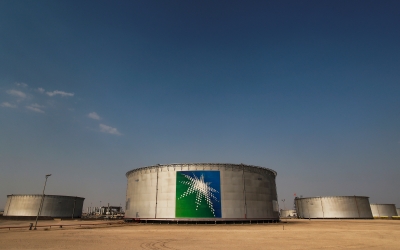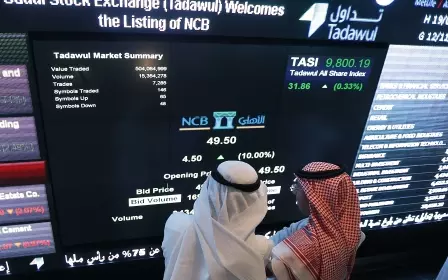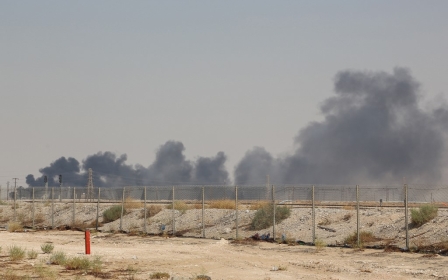Oil price turmoil: How Saudi Arabia's $100bn gambit could backfire

In 1985, US vice president George HW Bush visited Saudi Arabia to pressure the kingdom to flood the global market with cheap oil and squeeze the energy revenues of the Soviet Union.
The move pushed oil below $10 a barrel, reasserted Saudi Arabia's dominance as the world's top oil player, and dealt what some consider a crippling below to the ailing Cold War superpower.
Saudi Arabia has offered deep discounts to East Asia, and also to Europe to undercut Russian exports. This is a bold gambit
- Justin Dargin, Oxford University
Fast forward to March 2020, and an oil price war is being played once again, with consequences for Washington, Moscow and the entire global economy.
Recent production cuts agreed between Opec+ members, the global oil cartel, fell apart as Saudi Arabia clashed with Russia over prices and Riyadh raised production to 13 million barrels per day (bpd). The oil price dropped by 25 percent to $36 a barrel on Monday.
The move is considered a gambit by both Saudi Arabia and Russia, which did not want as deep a price cut as Riyadh, to counter the growing market share of the US shale industry.
New MEE newsletter: Jerusalem Dispatch
Sign up to get the latest insights and analysis on Israel-Palestine, alongside Turkey Unpacked and other MEE newsletters
"From the Russian point of view they are seeking a redistribution of market share, which is the same thing the Saudis want," said Theodore Karasik, a senior advisor to Gulf State Analytics, a Washington-based consultancy.
"This dance between the two is like a relationship between a separated couple; they are arguing over relationship dynamics and will soon recognise the market has adjusted to where they can sit down and clink glasses."
Such a pricing tactic was tried in 2014, when Opec upped production to bring prices well below $100 a barrel to muscle out the US shale sector, which required much higher extraction costs, at around $60 a barrel, to be competitive compared with conventional oil producers.
Saudi Arabia can pump a barrel of oil from certain fields for as low as a $1.
While many US shale businesses went bust and operations stalled, the move backfired.
"Operations became consolidated and more efficient, and the break-even price dropped," said Justin Dargin, an energy expert at Oxford University. "In a nutshell, the US shale industry actually became stronger and leaner, and is now better placed than it was 2014, able to sustain prices of around $30 a barrel for a bit of time.
"You can't put the genie back in the bottle, and that is a misreading they [Moscow and Riyadh] should have learned from 2014," he said.
Mortgaging the future
Before the 2014 price drop, the Gulf countries had amassed huge revenues when oil was over $100 a barrel. The National Bank of Kuwait (NBK) estimated in 2011 that for every $1 increase in a barrel of oil, Gulf Cooperation Council states accrued an additional $4.5bn a year in revenues.
But in the years since, with lower oil prices, GCC countries used such surpluses to keep their economies afloat and fund diversification strategies to wean their income generation off oil, such as the Vision 2030 programmes promoted by Saudi Arabia, Qatar and Abu Dhabi.
Since the last oil price cut, the GCC has burned through foreign reserves, but they rode it out. The discussion now is that they can't do it this time
- Guy Burton, adjunct professor at Vesalius College
"Since the last oil price cut, the GCC has burned through foreign reserves, but they rode it out. The discussion now is that they can’t do it this time," said Guy Burton, adjunct professor at Vesalius College in Brussels and a former assistant professor at the Mohammed Bin Rashid School of Government in Dubai.
The GCC's finances have become so perilous that the International Monetary Fund warned in a February report that "the region's aggregate net financial wealth, estimated at $2 trillion at present, would turn negative by 2034 as the region becomes a net borrower".
With oil prices at $100 a barrel, wealth would be exhausted by 2052, "while a real oil price of $20 a barrel would bring it forward to 2027".
Riyadh's price cut move could therefore speed up such a decline in revenues to within this decade, with a fiscal deficit of more than $100bn possible this year.
"If the price is low for an extended period it will put Vision 2030 at significant risk. They need to create six million jobs for the Saudi youth, and it was intended for much of that to be taken care of by the private sector," said Dargin.
Saudi Arabia's economy was already struggling, growing by just 0.3 percent last year, while the construction sector has dropped by 25 percent since 2017. Infrastructure projects have stalled, with investment nearly half in recent years from a peak of $40bn in 2014, according to regional projects tracker MEED Projects.
The kingdom's GDP per capita has also declined, from $25,243 in 2012 to $23,338 in 2018, according to the World Bank.
"There is a need to rethink these Vision 2030s, and revise them. Covid-19 has also destroyed plans," said Burton, with Riyadh having cancelled the Umrah pilgrimage this year and Dubai's 2020 World Expo in doubt.
The annual Hajj and Umrah pilgrimages are major contributors to Saudi Arabia's economy, attracting close to 10 million pilgrims per year and generating over $8bn in revenues, while the kingdom planned to attract 30 million pilgrims a year for Umrah under Vision 2030.
Given such blows to its economic prospects, "a lot of people looking at the [Saudi price cut] issue are saying, 'What are you doing? You are mortgaging your future,'" said Karasik.
But it is not only Saudi Arabia that will feel the pinch of lower oil prices.
Karasik said that while the Saudi price cut was aimed at bringing pressure on US shale, it had a secondary regional goal. "In a political sense, it is putting pressure on particular states to become subservient to those that have the cash.
"If oil is way below levels to balance state budgets in the Middle East, this is going to become a negotiating tool between stronger and weaker Arab states."
Pressure on Iran and Iraq
Iraq and Iran, both outside of Riyadh's political influence, will be particularly impacted, with a $10 drop in oil prices reducing conflict-riven Iraq's current account by $14bn, according to Institute of International Finance (IIF) calculations.
The result for Iran will be just as dire. "Iran is under renewed American sanctions, is a Covid-19 world hot spot, there were protests in the streets not too long ago and now, with oil around $30 a barrel, I don't know how Iran will be able to survive. It definitely doesn't look good for them," said Dargin.
Tehran has appealed to the IMF, for the first time since the early 1960s, for a $5bn assistance package to deal with the crisis. Iran has the world's highest fiscal break-even oil price - the price needed per barrel to balance the budget - at $194.6, while Saudi Arabia needs $85.7, the UAE $64.7 and Russia $42.
While Saudi Arabia's finances are not overly rosy, it can ride out lower prices to achieve its more immediate goals.
"We have to bear in mind that the economy's balance sheet is very strong, and has large amounts of government savings. While it will be running quite a large deficit, at 15 percent of GDP, that is not as bad as it was five years ago, and if oil prices recover then it will be smaller," said William Jackson, chief emerging markets economist at Capital Economics, a macroeconomic research firm in London.
The firm noted that oil production in Saudi Arabia, the UAE and Kuwait "would remain profitable even if oil fell to as low as $15 per barrel".
Saudi-East Asia ties
Burton said that as Saudi Arabia and other GCC states have been diversifying foreign investments, particularly to East Asia, the main buyer of Gulf crude, there is largess to weather a drop in oil prices.
"There is a deepening of economic relations, and it is both ways, between the Gulf and Asia. You can see they are hedging their bets," said Burton.
Anything can happen at this moment, with multiple black swans events, and we don't know how Covid-19 will impact oil production
- Justin Dargin, Oxford University
Saudi Arabia has also invested heavily in refineries in Asia to secure a long-term market share. The kingdom is South Korea's single largest oil supplier and has a stake in around half of the country's refinery capabilities, noted Karasik.
"Saudi Arabia has offered deep discounts [in oil] to East Asia, and also to Europe to undercut Russian exports. This is a bold gambit," said Dargin.
A further aspect of Riyadh's decision to bolster output is to lay the groundwork for new oil field developments slated to come online in the next few years, as well as in the UAE, a key ally of Riyadh.
Lower oil prices would allow these Gulf states to bring such new capacity onto the market, which would be hindered if they had to abide by the same production cuts under Opec+ agreements.
"A different type of energy market is emerging because of announcements of new discoveries of oil and gas in Saudi Arabia and the UAE. These need to be calculated into future demand and supply," said Karasik.
Calculating such future demand seems increasingly fraught, with the oil price now in lock-step with Covid-19, which has caused stock markets to drop, transportation to be interrupted, and propelled a deeper economic recession in the Middle East and much of the world.
Before the oil price cut, demand for oil was expected to decline by 0.3 million bpd in 2020, according to IIF, compared with growth of 1 million bpd predicted at the beginning of the year.
"Anything can happen at this moment, with multiple black swans events, and we don't know how Covid-19 will impact oil production - will oil workers even be able to get to work?" said Dargin.
Middle East Eye delivers independent and unrivalled coverage and analysis of the Middle East, North Africa and beyond. To learn more about republishing this content and the associated fees, please fill out this form. More about MEE can be found here.






